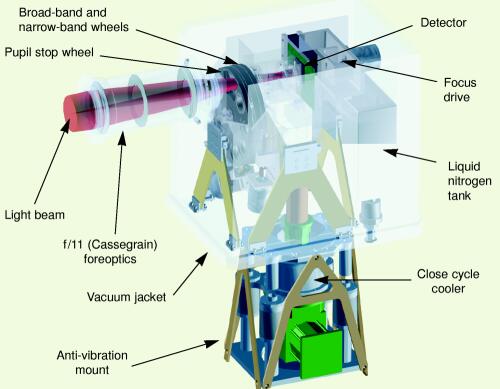INGRID forms an integral part of the ING's adaptive optics suite
NAOMI. Since early 2004 it has been
permanently attached to one of NAOMI's two science ports
in the environmentally controlled enclosure
GRACE
at the
WHT's Nasmyth
focus. The
1024x1024
HgCdTe Hawaii detector array has a pixel scale of 0.04"/pixel, with
a
resulting field of view of approximately 40" x 40", and a wavelength
range from 0.8 to 2.5 µm. More information on the detector can be
found
here. INGRID's two filter wheels
contain a range of broad and narrow band
filters
and a further wheel holds a selection of
pupil stops.
The diagram below shows a 3D transparent model of INGRID, with the
light beam from the telescope focusing on the infrared detector.

Picture
credit: Paul
Jolley (ING)
INGRID was mostly built and developed at the ING and was commissioned
in March 2000. It was originally deployed at both the Cassegrain and
Nasmyth focal stations to provide (i) a wide field imaging capability
over a ~4´x4´ field of view and (ii) a high resolution
imaging mode over a ~40"x40" field of view (with the AO system NAOMI).
However, following the
successful commissioning of
LIRIS
in 2003/2004, INGRID's wide field functionality at Cassegrain has been
replaced by
LIRIS's imaging mode, meaning that INGRID is now one of two dedicated
science instruments for NAOMI. In early 2004, INGRID underwent a
major reengineering program to improve its mechanism control system,
thus enhancing both the reliability and accuracy of its filter and
pupil wheels.


